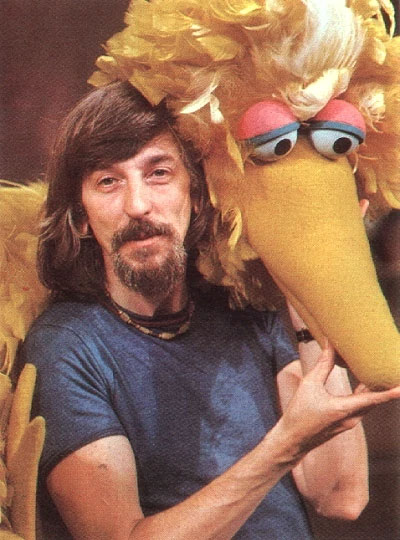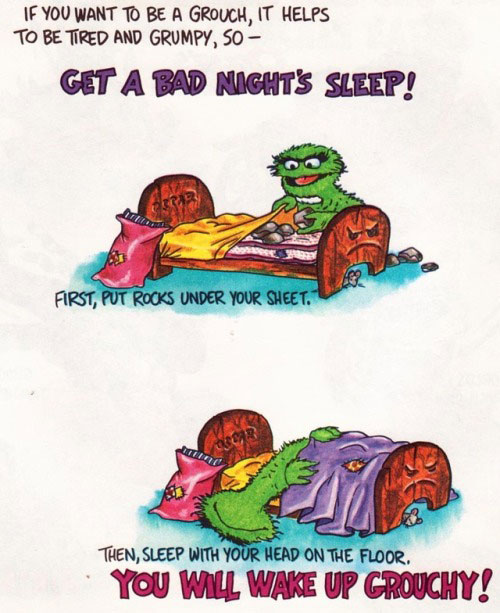'How To Be A Grouch'.
Caroll Spinney was an American puppeteer, best known for playing and voicing Big Bird and Oscar the Grouch on the long-running children's TV series 'Sesame Street' (1969) by Jim Henson. He performed their roles for nearly half a century. Lesser known is that Spinney was also active as an animator, illustrator and comic artist. During his military service he drew a gag comic titled 'Harvey'. Later in his career he occasionally illustrated 'Sesame Street'-related merchandise and the children's book 'How To Be A Grouch by Oscar the Grouch' (1976), which makes use of several sequential illustrations.
Early life
Caroll Edwin Spinney was born in 1933 in Waltham, Massachussets. He enjoyed drawing, painting and puppeteering from a young age. At age nine he was given his own Punch & Judy puppet theater. Spinney studied at Acton High School in Acton, Massachusetts, paying his college money through puppeteering in public.
Harvey
After graduation in the early 1950s, Spinney served in the U.S. Air Force. During this period he wrote and drew the gag comic 'Harvey' under the pseudonym "Ed Spinney", presumably for his base newspaper. It featured the antics of a not-too-bright soldier, Harvey, and his frequent run-ins with Colonel Flushwell. Stylistically it was obviously inspired by Mort Walker's famous army comic 'Beetle Bailey', down to the fact that Harvey too had no visible eyes.
Puppeteering career
In 1955 Spinney became a professional puppeteer. While he also made animated shorts (the 'Crazy Crayon' cartoon series in the 1960s) and live drawings when appearing on variety shows, he was first and foremost known as a puppeteer. His main puppet characters were two cats: Picklepuss and Pop. As early as 1962 Spinney caught the attention of Jim Henson, who performed with an advanced type of puppets and marionettes which he dubbed 'Muppets'. The Muppets were notable for being more expressive than traditional puppets. Henson wasn't famous yet at the time, but thanks to frequent TV appearances he received more and more commissions. He tried to have Spinney join his team, but he misunderstood Henson's message and therefore it took until 1969 before Henson asked him again and Spinney signed up.
Sesame Street
In 1969 Henson and the Children's Television Workshop produced the children's TV show 'Sesame Street'. Ever since black people in the U.S. had been given equal civil rights in 1964, efforts were made to help improve their chances in society. The program was originally intended to help children in the African-American community overcome their learning disadvantage and, in a wider goal, kids in poorer areas everywhere. Because no matter how poor people were, almost every household at least had access to television. 'Sesame Street' taught basic educational material, such as the alphabet and numbers, but also social skills and values. Originally the show made a clear distinction between scenes involving actors interacting with children in a TV studio and prerecorded sketches involving puppets. However, when test screenings proved that young viewers were more interested in the puppets, it was decided to make them interact with humans as well.
Big Bird
Henson and his team designed many iconic characters, such as Kermit the Frog, Cookie Monster, Count von Count, Grover and Bert & Ernie. Spinney was given the parts of Big Bird and Oscar the Grouch. Big Bird is a huge yellow canary who, despite his size, is still a naïve young child, and therefore is the character most young viewers identify with. Whenever the creators want to address a certain issue from a child's viewpoint, Big Bird is usually used as the personification. In one of the show's most (in)famous episodes, the death of the character Mr. Hooper (whose actor Will Lee had recently died in 1982) was written into the show's continuity. Big Bird at first doesn't understand the concept of death, but slowly realizes that it means his good friend will "never come back". The drawing he makes of Mr. Hooper to "remember him" at the end of the broadcast was original artwork by Spinney. At the time, the episode was controversial for addressing such a morbid subject in a children's show. Nevertheless, most people praised it for discussing an unavoidable topic every child should learn to deal with. Spinney considered it his crowning professional achievement.
Foreign versions of 'Sesame Street' have included Big Bird in their cast too. Sometimes without much change, like his counterpart Da Niao in the Chinese-language version. In other countries the bird has a different color, such as blue (Pino in the Netherlands, Garibaldo in Brazil) or orange (Minik Kuş in Turkey, Poupas in Portugal) or is a different bird species altogether, such Abelardo Montoya, the green parrot in the Mexican version of the show.
Caroll Spinney and Big Bird.
Oscar the Grouch
While Big Bird is a nice and cheerful character on 'Sesame Street', Oscar the Grouch is the complete opposite. He's a cynical, misanthropic monster who lives a trash can. His unsympathetic behavior is mostly used in contrast to the nicer behavior of other characters. While Oscar is often mean, he isn't performed as a villain. Other characters still treat him as a friend, learning young viewers that even such people deserve respect. Despite all this, Oscar has his nicer side too, especially when interacting with real children. In foreign versions of 'Sesame Street' Oscar is either dubbed or replaced by similar grouchy puppets.
Sesame Street success
Spinney nearly left the show after the first season over a pay dispute, but was persuaded to stay. He eventually grew very fond of Big Bird, who gave his life more purpose. Throughout the 1970s, 'Sesame Street' grew into a global phenomenon. The show rose above its original purpose of only educating poorer children and became the high-quality children's education show all other programs in the genre took inspiration from. 'Sesame Street' won numerous awards and featured guest appearances of many celebrities, from actors, TV presenters over musicians and sportspeople to even politicians. The format was sold to many countries all over the world. Spinney performed his characters in films produced by Jim Henson Productions, such as 'The Muppet Movie' (1979) and 'Follow That Bird' (1985), while doing the same in several TV shows and other public events. In 1990, he sang Kermit's theme song 'Bein' Green' at Jim Henson's funeral service.
From: 'How To Be A Grouch'.
Illustration work
Caroll Spinney illustrated the picture book 'How To Be A Grouch' (1976, supposedly written by Oscar the Grouch, but in reality written by J. Milligan). The book features Oscar explaining to children how to be a disgruntled monster like him. Other chapters offer a look into Oscar's family life. Precisely because the work is presented as a "How To..." book, Spinney visualizes several actions and presentations in sequential drawings. An audio version of the book was also made available, with Spinney voicing Oscar.
Recognition
Spinney won a Daytime Emmy for Outstanding Individual Achievement in Children's Programming (1974, 1979), Outstanding Performer in a Children's Series (2007) and co-won for Outstanding Children's Programming (1976). In 1984 a Daytime Emmy for Special Classification of Outstanding Individual Achievement – Performers was handed out to him, and in 2006 he received the Daytime Emmy Lifetime Achievement Award. He also received the Behind the Voice Actors Award for Best Male Vocal Performance in a Television Series – Children's/Educational (2015) and co-won Best Vocal Ensemble in a Television Series – Children's Educational (2015). In 1994 Big Bird was honored with a star at the Hollywood Walk of Fame and in 2000 with a Library of Congress' Living Legend Award. In 2019 'Sesame Street' won the Kennedy Center Honor, with Spinney being one of the people being honored.
Final years and death
Since 1998 Matt Vogel was trained as an understudy to perform Big Bird, taking over the role completely since 2015. Eric Jacobson did the same for Oscar since 2014, though in both cases Spinney kept performing the voices for the characters until he retired on 17 October 2018, because he suffered from the neurological disease dystonia. He lived long enough to experience the 50th anniversary of 'Sesame Street' in November 2019, but died in early December, a few weeks before what would've been his 86th birthday.
Documentary about Caroll Spinney
For people interested in Spinney's life and career, his autobiography 'The Wisdom of Big Bird (and the Dark Genius of Oscar the Grouch', 2003) and the documentary 'I Am Big Bird: The Caroll Spinney Story' (2014) are highly recommended.








